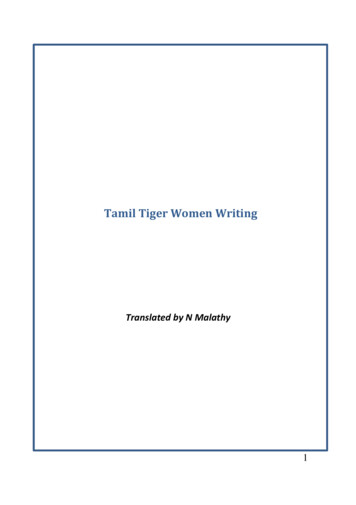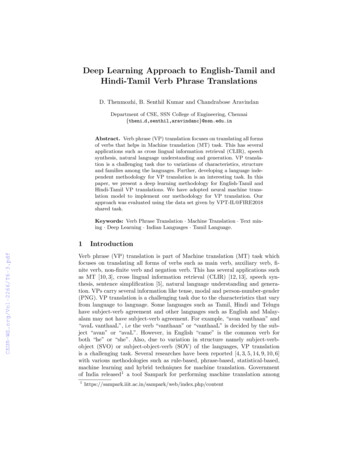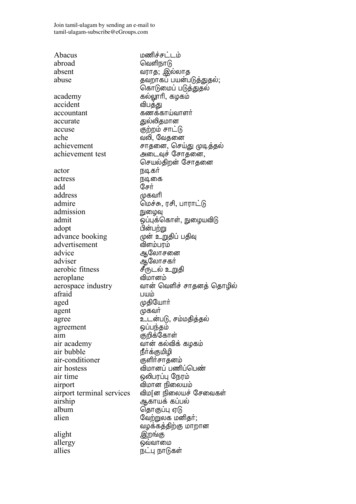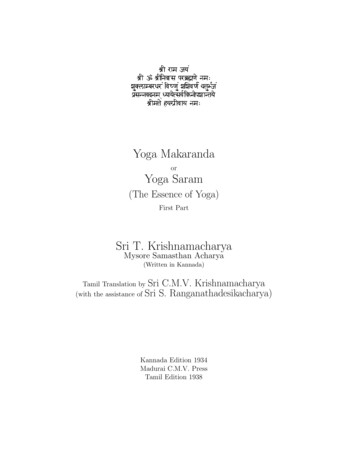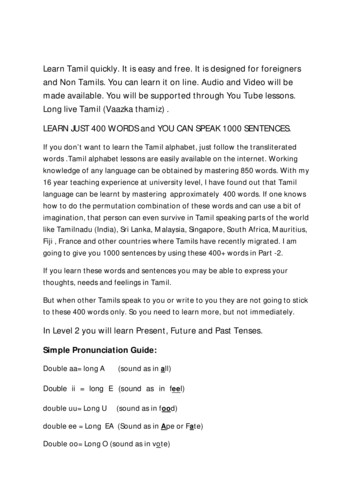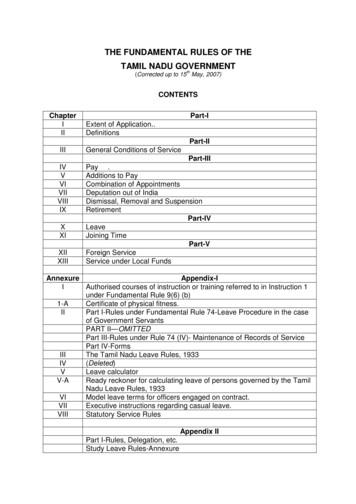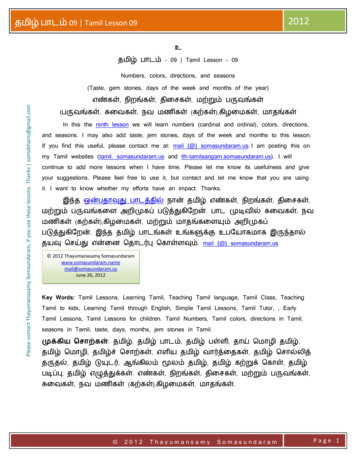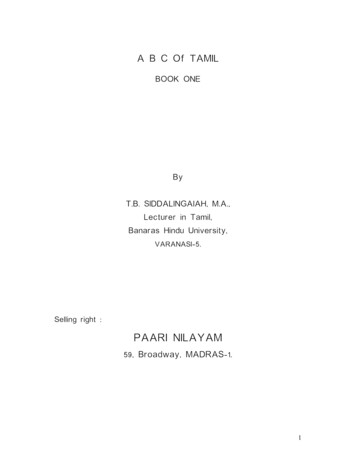
Transcription
A B C Of TAMILBOOK ONEByT.B. SIDDALINGAIAH, M.A.,Lecturer in Tamil,Banaras Hindu University,VARANASI-5.Selling right :PAARI NILAYAM59, Broadway, MADRAS-1.1
DEDICATED TOMy Grand-fatherSRI. T.M. RAMALINGAIAH,who was also my first Teacher2
Dr. M. Varadarajan, M.A., M.O.L., Ph.D.,Professor and Head,Department of Tamil,University of Madras.FOREWORDTamil is one of the most ancient languages of the munication. It belongs to the Dravidian family of South Indiaand has a hoary literary tradition 2000 years old. It is found to bea useful vehicle of modern thought as well. There are manywriters even now enriching the language through their poetry andfiction as well as book of knowledge.It is quite natural that many non-Tamils now desire to learnthe language but good guide books written in a practical anduseful method are not found. Thiru T.B. Siddalingaiah, a wellknown and erudite scholar, has brought out this book ‘ABC ofTamil’ and fulfilled a long-felt need. While writing this he had inview the grammatical peculiarities of the language as well as thedifficulties in pronunciation and syntax experienced by the nonTamil students in learning it. His experience in teaching Tamil inDelhi, Calcutta, Varanasi and other centres has enabled him tounderstand their problems and to present every step in a clearand simple manner. Obviously he is not in favour of teaching thespoken dialects alone without any heed to the standard language3
or the written language. I, too, have found that method lessuseful. Many non-Tamils who learned only the spoken form findthemselves unable to read or write a few sentences in thelanguage and when they cease to have any contact with thepeople of the language forget it altogether.The object of this book is to assist non-Tamils in India andelsewhere at the beginning of their study of the Tamil language.Therefore, the system of the language has been explained hereas far as it is essential for the beginners. The examples andillustrations given are quite apt and adequate, simple and direct.It is my earnest hope that the two more books promised bythe author will be brought our early. By completing this project hewill be one of those men of learning who render valuable serviceto humanity by bringing minds together.M. Varadarajan4
PREFACEThe Indians, after the advent of Independence, are moreconscious, than before, of their values and traditions. The interestamong our people to know more about ourselves--our languages,literature, culture, customs and manners, habits and beliefs etc., gration, and finally help our country emerge as a great andintegrated nation.As a beginning one section of the Indians is trying to learnthe language of another part of the country and through it theliterature and the contribution of that language group to the Indianculture.The Government also have taken steps to encourage this.The Uttar Pradesh Government have started classes for teachingSouth Indian Languages to the North Indians. This book is ahumble, earnest attempt to participate in this great movement.This is not a Text Book. This is a ‘guide’ to know therudiments of the Tamil Language. This is not meant to be a ‘selftaught’. One has to take the guidance and help, now and then,from somebody whose mother-tongue is Tamil.There is a wide gulf between the written (standard) Tamiland the spoken language. It will be a futile attempt to teach thespoken language, through a book, to the people of differenttongue. The spoken language varies from place to place, is5
spoken differently by different castes, with varying intonations,and employs a different diction according to the region and thepeople who speak. So I have tried to give in this book only thestandard, written Tamil.I have been teaching Tamil to Non-Tamils since about adecade and a half. I had employed various methods in myattempt to teach this language. Finally, I found, this method, whichhas been adopted in this book, was more successful than therest. Two more books, besides this, will be published to completethis series.I take this opportunity to thank and pay my humble respectsto my professor, Dr. M. Varadarajan, Professor and the Head ofthe Department of Tamil, Madras University, for having kindlygone through the manuscript, putting in valuable suggestions andwriting an instructive foreword. I am indebted to my godfather,Mr. G.V. Pillai, whose suggestions have improved the text of thebook.I thank my esteemed friend, Prof. K.N. Srivastava, Principal,Queen’s College, Varanasi, who was a source of strength andencouragement all along.MyheartythanksaredueVenkatapati, Mr. Tambi SrinivasantomyfriendsMr.S.P.and Mr. C. Balasubramaniam,M.A., M.Litt., without whose help this book would not have seenthe light of the day.6
ran Press, Madras, for completing the work in recordtime.VaranasiSiddalingaiahFeb., 1968.7
CONTENTSLessonPagesForeword. . . . .5Preface. . . . .7Introduction. . . . .91.Vowels. . . . .102.Consonants. . . . .113.Consonantal Vowels (contd.). . .144.”. . .155.”. . .176.”. . .187.”. . .208.Number. . .229.Consonantal Vowels (contd.). . .2310.”. . .2511.”. . .2712.Conjunction. . .2813.Consonantal Vowels (contd.). . .3114.”. . .3215.”. . .3316.More Letters. . .3417.Tenses--Present. . .3818.Present Tense (contd.). . .4219.Cases. . .4420.Cases (Dative). . .4921.Cases (Genitive). . .568
INTRODUCTIONFour main language are current in South India. They areTamil, Telugu, Kannada and Malayalam. Theses are called theDravidian Languages. There are other languages, too, whichbelong to this family, but they are not so much developed asthese four. Hence these are important.Telugu, Kannada and Malayalam languages have borrowedfrom Sanskrit, the sounds and words. But Tamil has tried and hassucceeded in its attempt to remain almost unaffected by theinfluence of that great language, Sanskrit. As such Tamil isconsidered to be the most difficult of the Dravidian Languages tolearn. It cannot be denied that Tamil also has borrowed wordsfrom Sanskrit. But the percentage of words borrowed, comparedto the other languages of the same family, is very much less.And many of the borrowed words also have assumed a newform (Tat bhava) according to the genius of Tamil.9
LESSON ONE : VOWELSThere are twelve vowels in Tamil.They are:1.Ü- Pronunciation is like the vowel sound in ‘but’, cut and‘shut’.2.Ý--do. . . . . .‘cot’ and ‘pot’.3.Þ--do. . . . . .‘tin’ and ‘pin’.4.ß--do. . . . . .‘feet’ and ‘sheet’.5.à--do. . . . . .‘put’ and ‘foot’6.á--do. . . . . .‘moon’ and ‘mood’.7.â--do. . . . . .‘emit’ and ‘emblem’.8.ã--do. . . . . .‘ape’ and ‘mane’.9.ä-do. . . . . .‘idle’ and ‘item’.10.å--do. . . . . .‘omit’ and ‘opinion’11.æ--do. . . . . .‘show’ and ‘coal’ .12.å --do. . . . . .‘fowl’ and ‘now’.There is another letter added to this list.çNotes :‘â’pronounced almost like ‘ach’ in ‘stomach’.and‘å’are the two sounds which are not foundin Sanskrit. These sounds are common to all the Dravidianlanguages.Exercise : Practise with pronunciation :Ý, Þ, ä, å , á, ß, Ü, ã, â, æ, å, à.10
LESSONTamil hase.g.,TWO : CONSONANTS18 consonants. They are denoted with a dot above.è , ì , ð , ñ ,(k, t, p, m).As it is difficult to pronounce aconsonant by itself, the first vowel,pronounced. e.g.,è, ì, ð, ñÜ,is added to and(ka, ta, pa, ma)è-pronounced as the ‘k’ in ‘bake’ and ‘cake’.é--do- -do-nasal sound in ‘sing’.ê--do- -do-‘ch’ in ‘chip’ and ‘birch’.ë--do- -do-nasal sound in ‘ginger’ì--do- -do-‘t’ in ‘cut’ and ‘put’.í--do- -do-the nasal sound in ‘round’.î--do- -do-‘th’ in ‘mirth’ and, ‘birth’ï--do- -do-the nasal sound in ‘tin’ and ‘skin’ð--do- -do-‘p’ in ‘pun’ and ‘shop’.ñ--do- -do-the nasal sound in ‘mum’ and ‘boom’.ò--do- -do-the ‘ya’ in ‘young’.ó--do- -do-the ‘r’ in ‘rust’ and ‘rum’.ô--do- -do-the ‘l’ in ‘lump’ and ‘lung’õ--do- -do-the ‘v’ in ‘vulture’ and ‘vulcanize’ö-pronunciation of this letter is something like the firstsyllable in the French word ‘Jean’. Now-a-days ‘ö’indicated by ‘zh’ in transliteration or-is‘l’. -pronounced as the ‘l’ in ‘pearl’ø-- do- -do-]‘rrh’ in ‘catarrh’ù-- do- -do-]‘n’ in ‘nun’ (This is an alveolar sound).11
There is no difference in modern usage, in pronouncingand'ù’,So also there is no difference betweenin pronunciation except, when‘ø’is doubled.‘ï’‘ó’and‘ø’,‘ó’is neverdoubled.Consonants are shown with a dot above.è , ì , ñ , ù , ô , ö ,(k, ţ, m, n, l, l)Consonantal vowels are the consonants added with a vowel.e.g.,Consonantal vowel.è Ü è(consonantal vowel)ì Ü ì-do-í Ü í-do-Consonants are with dots above them. Consonantal vowels(withÜ)are without the dots.Now we shall see a few words.Two-lettered words:èí (kaņ) -an eyeñí -(maņ) - the earthèô (kal) -a stoneðô -(pal)- a toothâù (en) -myàù -(un)- your (singular)Ýñ (am) -yesáó -(ur)- a town or a village(a habitat)12
Three-lettered words:èìô - (kadal)- the seaðìñ - (padam) - a pictureðèô - (pagal)- daytimeñíô - (maņal)ñèù - (magan) - son- the sandñè - (magal) - daughter- a fruitÝöñ - (alam)- depthñóñ - (maram) - a treeÜõù - (avan)- heÜõ - (avaļ)- sheãù -(en)- whyÜï î - (anda)- that;Þï î -(inda)- this;ðöñ - (palam)âù ù- (enna)Notes :- what;è, ì, î, ðâï î - (enda)- whichïô ô - (nalla)- good (adjective)(ka, ta, ta, pa) - These four letters arepronounced as ga, da, da and ba, when they follow another letteror a nasal sound.e.g.,èô -preceded by‘Üï î’ ‘î’kal - a stone.‘ð’ðèô (pagal) - daytime. In this‘è’isand so the pronunciation is changed into ‘g’. Inis pronounced as ‘da’ as it follows the nasal sound‘ï ’,Doubling of letters, (eg.,è è, ô ô), is a common feature inTamil. In doubling, the letters retain their original pronunciation.Practise with pronunciation :âï î, ñèù , ðìñ , ðíñ (money),(toddy),ñè , ñóñ , èô , èí , è ïô ô ñóñ , ïô ô ðöñ , âù èí , àù ñè , âù ù ðöñ ?Üï î ñóñ , âï î ñíô ?13
LESSONTHREE :CONSONATAL VOWELS (contd.)In this lesson we shall see the combination of the secondvowel.‘Ý’, with the consonants.The symbol to denote the lengthened‘Ü’ (Ý) is‘ ’è Ý è (kā)ñ Ý ñ (mā)é Ý é (nā)ò Ý ò (yā)ê Ý ê (chā)ó Ý ó (rā)ë Ý ë (ñā)ô Ý ô (lā)ì ì (ţā)õ Ý õ (vā)í Ý í (ņā)ö Ý ö (lā)î Ý î (tā) Ý (ļā)ï Ý ï (nā)ø Ý ø (rā)ð Ý ð (pā)ù Ý ù (na)è ô -kal- a legõ ô -val-ð ô -pal- milkõ ò -vay - mouthï ò -nay - a dogõ ö -val- to liveÝí -aņõ -va- (you) comeï ù -nan - Iî -ta- (you) giveï -naļò ó -yar- who?ð ìñ - padamÜð ð - appa - father Ýwords:- male- a day- a lessona tailè ôñ - kalam - timeÜñ ñ - amma - mother14
î î î - tatta - grandfatherñ îñ - madam - a monthïô ô ð ìñ - a good lessonâù è ô àù Üñ ñ - your motherï ù ò ó - who (am) I?ïô ô ï - a good day- my legàù Üð ð ò ó ? who (is) your father?Notes : The following consonantal-vowels can never be the firstletter of any Tamil word : é, ì, í, ó, ô, ö, , ø & ù, Theconsonant ‘é ’ and consonantal vowel ‘é’ only are in use. Otherconsonantal vowel forms of ‘é’ are not in use. As such thecombination of é with other vowels need not be learnt.Practise with pronunciation :âù î î î ; Þï î ñóñ ; âï î ï ? ïô ô ð ô ; àù õ ò ; õ .LESSON FOUR : CONSONANTAL VOWELS (Contd.)In this lesson we shall try to learn how the vowel ‘Þ’ isadded to the consonants. The symbol for this is “ ”, which isadded to the right of the consonants.è Þ è (ki)ñ Þ ñ (mi)ê Þ ê (chi)ò Þ ò (yi)ë Þ ë (ñi)ó Þ ó (ri)ì Þ (ţi)ô Þ ô (li)í Þ í (ņi)õ Þ õ (vi)î Þ î (ti)ö Þ ö (li)ï Þ ï (ni) Þ (ļi)ð Þ ð (pi)ø Þ ø (ri)ù Þ ù (ni)15
words:âô -eli-a ratðù - pani - dewÞ idi-thunderãó -è -kiļi -õö -vali -a parrotpath- ēri - a lakeãí - ēņi - a ladderð - padi - to readï ô - nila- full moonÜí ô - aņil - a squirrelðò ó - payir - cropñò ô - mayil - a peacockîò ó - tayir - curdîñ ð - tambi - younger brother õí - vaņdi - a cart,a vehicle.Notes:‘ ’ is the symbol for the vowel ‘Ý’, when it combines withconsonants. ‘ó’ is a consonantal vowel. Its consonant is ‘ó ’. This iswritten with a dot above (ó ). These two should not be confused.The difference is in the downward oblique stroke from right toleft. However whenwriting the consonantal vowel forms of‘ó ’other than ‘ó’ and ‘ó ’, the downward oblique stroke may beomitted as there is no likelihood of such consonantal vowel formlike ‘ó ’ being confused with the vowel symbol for ‘Ý’.Practise with pronunciation :âô , àù è , ïô ô õö , Þï î ñò ô , âï î Üí ô , âù îñ ð , Üï îãó , ð ìñ ð , (you) read (a) lesson.16
LESSON FIVE : CONSONANTAL VOWELS (contd.)Combination of the vowel ‘ß’ with the consonants. Thesymbol is‘ ’.è ß è (ki)ò ß ò (yi)ê ß ê (chi)ó ß ó (ri)ë ß ë (ñi)ô ß ô (li)ì ß (ti)õ ß õ (vi)í ß í (ni)ö ß ö (li)î ß î (ti) ß (li)ï ß ï (ni)ø ß ø (ri)ð ß ð (pi)ù ß ù (ni)ñ ß ñ (mi)words :î -(ti)-fireï -(ni)-you (singular)è ó -(kiri)-a mongooseï é è -(ningal)-you (honorific and pluralas well)ï ó -(nir)-waterï õ -you comeîí í ó (îí ï ó )-taņņir-cold waterñ ù -min-a fishè ö -kil-below.‘ï ’ stands for ‘you’ (singular), ‘ï é è ’ stands for plural ‘you’. It isalso used as a respectful form of address in the singular.17
ï - nominative case, you; àù - genitive case, your (singular).ï é è - you (plural and honorific) - nominative case.àé è - your(-do-)- genitive case.Rule :It can be generalized that ï ù , ï ñ and ï é è (I person) changeinto âù , âñ , âé è , respectively. So also ï and ï é è (II person)change into àù and àé è , respectively.Practise with pronunciation :àù è ó ; ‘âù ñè ’; Þï î ñ ù ïô ô ñ ù - This fish (is) agood fish.LESSON SIX : CONSONANTAL VOWELS (contd.)Thesymbol for ‘à’ is ‘ ’ ٯ . This varies according to theform of the consonant.è à (ku)ò à »(yu)ê à ²(chu)ó à ¼(ru)ë à ³(ñu)ô à ½(lu)ì à (ţu)õ à ¾(vu)í à µ(ņu)ö à ¿(lu)î à ¶(tu) à À(ļu)ï à (nu)ø à Á(ru)ð à ¹(pu)ù à Â(nu)ñ à º(mu)18
words :¹ô -pul-grassï - nadu- a country- an earº -muļ -a thornè ¶ -kadu¹¿-pulu -a wormæ ¹¶-pudu - new (adj)ð - padu- to singÝ -adu - a goat - to drinkÝÁ -aru - a river¶í - tuni- a clothõ -vidu - a houseã¿ - elu- seven- odu- kūdi- to runÞ¶ - idu - This (demonstrative pronoun); å¼ - oru - (numericaladjective)ܶ - adu - thatâ¶( - do - ) ;⼶ - erudu - an ox- edu - which ( - do - ;Þù Á - inru - todayèî¾-kadavu-a doorðì -padagu-a boatð ñ ¹-pambu-a snakeèì¾ -kadavuļ-Godð ì -paţţu-a songï è -nakku-a tongueñ¼ï ¶-marundu-medicine óé -kuran gu-a monkey¹î îèñ -puttagam -a bookåù Á-onru-OneÞóí -iraņdu-Twoï ù -nangu-Fouräï ¶-aindu-FiveÝÁ-aru-Six19
ã¿-elu-Sevenâì -eţţu-Eightåù ð¶-onbadu-Nineðî ¶-pattu-TenNotes :Þ¶ - This (a demonstrative pronoun). e.g. Þ¶ âù õ (This(is) my house. Wherese ‘Þï î’ is an article. e.g., Þï î õ àù õ (This house (is) your house). This applies to Üï î, ܶ and âï îand â¶, also.All the numerals end with ‘à’ :Practise with pronunciation :âù õ ¹¶ õ . àù è ó â¶? (which) (is) your mongoose? ñ¼ï ¶ (you) drink medicine). Þ¶ å¼ ïô ô ð ì (This (is) a goodsong). ï ð (you sing).LESSONSEVEN :CONSONANTAL VOWELS (contd.)When the vowel ‘á’ is added to the consonant, generally,the‘à’ symbol is extended. Again this symbol varies accordingto the shape of the consonant.è á Ã(kū)ò á Î(yū)ê á (chū)ó á Ï(rū)Å20
ë á Æ(ñū)ô á Ö(lū)ì á Ç(tū)õ á (vū)í á È(nū)ö á Ø(lū)î á É(tū) á Ù(ļū)ï á Ë(nū)ø á Ú(rū)ð á Ì(pū)ù á Û(nū)ñ á Í(mū)Ìí - puņdu- garlicwords :Ì-pu-a flowerà -kudu -a nestÉè èñ - tukkam - sleepÍ -mudu -to shutÌì - pūţţu- a lockÉé -tungu - to sleepÉí - tuņ- a pillarÃì ìñ -kuţţam - a crowedËô - nūl- a thread, abook (literary use)Íù Á-munru - threeÃí -kuņdu - a cageNotes :Íù Á (Three) is the only word which has a long ‘u’ (á).Othernumerals have only short ‘u’ (à).‘å¼’ is the adjectival form ofåù Á.Practise with pronunciation :Þ¶ å¼ Ã . (This is a nest)ï Éé . (you sleep.)21
Þ¶ å¼ Éí (This is a pillar.)LESSONå¼ Ì(one flower.)EIGHT : NUMBERIn English, generally, ‘s’ or ‘es’ is added to a singular nounto make it a plural one. In certain cases the nouns take differentsuffixes.In Tamil ‘è ’ is the plural suffix. This does not vary.èí (an eye) è èí è (kaņgaļ) eyesáó (a village or a town) è áó è (urgaļ) villages ortowns.õ (house) è õ è (vidugaļ) houses.è ô (a leg) è è ô è (kalgaļ) legs.õö (path) è õö è (valigaļ) paths.èî¾ (a door) è èî¾è (kadavugaļ) doors.The last letter of the first word (to which the plural suffix‘è ’ is added) changes according to the sound of ‘è ’, in certaincases.ðöñ è ðöñ (é )è ðöé è -palańgal - fruitsñóñ è ñóñ (é )è ñóé è -marańgaļ - trees.ðìñ è ðìñ (é )è ðìé è -padańgaļ- pictures.èô è èô (ø )è -karkaļ èø è - stones.22
In certain cases the ‘è’ in ‘è ’ is doubled.Ì è Ìè è Ìè è -pūkkaļ- flowersß è ßè è ßè è -īkkaļ- flies.Notes :The consonants are arranged in such a way that anasal sound forms a relative letter of the previous letter. e.g., ‘è’is followed by ‘é’. So ‘é’ is the relative sound ofë; ì-í; î-ï; ð-ñ; ø-ù;changes into ‘é ’‘è’. So are ê-Therefore, when “ñ ” precedes ‘è’, ‘ñ ’to make it easy to pronounce. e.g., ðöñ è ðöé è .Practise with pronunciation :(1)Give the plural forms of :õí , è ó , è , ¶í , ñôó (flower), óé , Üí ô , ãó , îñ ð , ¹î îèñ , ÝÁ, Éí .(2)Translate into Tamil :A good river ; Five goats ; Twosnakes ; Seven countries.LESSONNINE : CONSONANTAL VOWELS (contd.)When the vowel ‘â’ (short) is added to the consonants thesymbol ‘ª’ is put before the consonants. This symbol is nothingbut a modification of the letter ‘â’. ‘â’ ‘â’ ‘ª’.è â ªè(ke)ò â ªò(ye)ê â ªê(che)ó â ªó(re)ë â ªë(ňe)ô â ªô(le)ì â ªì(ţe)õ â ªõ(ve)23
í â ªí(ņe)ö â ªö(le)î â ªî(te) â ª (ļe)ï â ªï(ne)ø â ªø(re)ð â ªð(pe)ù â ªù(ne)ñ â ªñ(me)words :ªêò -chey-to doªðì - peţţi- a boxªê -chedi -a plantªèì ì-- bad (adj.)ªðí -peņ-ªïò - neyªïô -nel- paddya girlkeţţa- gheeâí ªíò - eņņey- oilªõí ªíò - veņņey - butterªðó ò- periya- big (adj.)ªðòó -peyar - a nameê ø ò- chiriya- small (adj.)Notes :As it is in English, in Tamil also adjectives do notchange according to the number and gender of the noun thatfollows. e.g.,ïô ô ªðí - (a) good girlïô ô ï ò è - good dogsªðó ò õ - (a) big houseªðó ò ªðí - (a) big girlê ø ò Éí - (a) small pillaräï ¶ ê ø ò ñ ù è - five small fishPractise with pronunciation :Translate into English.1.å¼ ªðó ò ÝÁ2.ÝÁ ê ø ò õ è 3.ï ù ªèì ì âô è 4.ïô ô ªðí 24
5.àù ªðòó âù ù?6.âù ªðòó º¼èù .7.ܶ å¼ ïô ô Üí ô .LESSONTEN :CONSONANTAL VOWELS (contd.)The symbol for the vowel ‘ã’ (long) is only an extenstion ofthe symbol of ‘â’ :ª « (for ‘ã’)è ã «è(ke)ò ã «ò(ye)ê ã «ê(che)ó ã «ó(re)ë ã «ë(ñe)ô ã «ô(le)ì ã «ì(ţe)õ ã «õ(ve)í ã «í(ņe)ö ã «ö(le)î ã «î(te) ã « (ļe)ï ã «ï(ne)ø ã «ø(re)ð ã «ð(pe)ù ã «ù(ne)ñ ã «ñ(me)words :«è -keļ-to listen to; to question.«î -teļ-a scorpion.«õó -ver-a root.25
«ñô -mel-«ñ«ô-mēlē-«êõô -cheval-a cock.«è õ -keļvi-a question.«îù -ten-honey.«ðù -pen-a louse.«îó -ter-a chariot.«õô -vel-a spearè ö -kil-beneath,è «ö-kile-below, under.Üé «è-an gē-there.Þé «è-inge-hereâé «è-en gē-whereupon, aboveNotes : Prepositions get that name because they are placedbefore the nouns. But in Tamil (as in other Indian languages) theyappear after the nouns (postpositions). At times they serve asadverbs also.e.g. è «ö ð ó - see below.«ñ«ô ð ó - see above.Practise with Pronunciation:I) Translate into English: (1) ï Þé «è õ . (2) Üé «è ð ó (3) è «öõ (4) ïô ô «îù (5) ªðó ò «îó :II) Translate into Tamil: (1) See there (2) Come here. (3) Eightspears. (4) Four scorpions. (5) Seven lice.26
LESSON ELEVEN: CONSONANTAL VOWELS (Contd.)Symbol “ ” is put before a consonant to denote thecombination of that consonant with the vowel ‘ä’. This symbol isnothing but the upper portion of that letter ‘ä’ ‘ ’è ä è (kai)ò ä ò (yai)ê ä ê (chai)ó ä ó (rai)ë ä ë (ñai)ô ä ô (lai)ì ä ì (ţai)õ ä õ (vai)í ä í (ņai)ö ä ö (laiî ä î (tai) ä (ļai)ï ä ï (nai)ø ä øð ä ð (pai)ù ä ù (nai)(rai)ñ ä ñ (mai)Words: è-kai- a handñ ô - malai - a mountain î-tai- to sewÞ ô - ilai - a leaf ð-pai- a bagõ ö - valai - banana ñ-mai - inkð ø - paraiÌ ù-punai - a catè ô - kalai - morningò ù -yānai - an elephant öï î - kulandai - a childñ ô -malai - eveningªîù ù - tennai - cocoanut ì -kudai - an umbrellaÞô ô - illai - no«õ ô -velai - work î ó - kudirai - a horseî ô -talai - a headï - naļai - tomorrowõ ô -valai - a net- a rock27
‘ä’ is a combination of two sounds. ie., Ü and Þ, and ispronounced as ‘Üò ’. As such many people employ ‘Üò ’ in placeof “ä”. eg., äòó î ôõó Master - Üò òó .Practise with pronunciation: :I) Translate into English. (1() âù «õ ô (2) å¼ Ì ù (3) àù î ô, (4) ï ñ ô.II) Translate into Tamil: (1) Two horses. (2) An elephant (3) Fivechildren (4) A big rock (5) This mountain. (6) Which net? (7) Abanana leaf.LESSON TWELVE: CONJUNCTIONConjunction combines two words or sentences. Now weshall take up the conjunction ‘and’, The Tamil equivalent of this is“àñ ”. This “àñ ” is added to the words at the end.In English ‘and’ is placed in between two words which are tobe combined. e.g., Rama and Krishna. In Tamil ‘àñ ’ is added toboth the words.If there are more than two nouns (words) to be puttogether ‘and’ is placed before the last word. In Tamil ‘àñ ’ is tobe added to every word.28
Üõù , Üõ Üõù (àñ ) Üõ (àñ ) ÜõÂñ ÜõÀñ (he and she)ñóñ , ðöñ ñóñ (àñ ) ðöñ (àñ ) ñóºñ ðöºñ (tree and fruit)ñ ù , ñ ñ ù (àñ ) ñ (àñ ) ñ Âñ ºñ (fish and tank)ï ò , ðòù ï ò (àñ ) ðòù (àñ ) ï »ñ ðòÂñ (dog and boy)I. In certain cases the last consonant (of the word) beforetaking ‘àñ ’ gets doubled.èí (eye) àñ èí (í ) àñ èí µñ ªïô (paddy) àñ ªïô (ô ) àñ ªïô ½ñ èô (stone) àñ èô (ô ) àñ èô ½ñ ¹ô (grass) àñ ¹ô (ô ) àñ ¹ô ½ñ ªðí (girl) àñ ªðí (í ) àñ ªðí µñ ªïò (ghee) àñ ªïò (ò ) àñ Rule : ªïò »ñ If the existing word is a two-lettered word and thefirst letter is with a short vowel and the second (last)letter is a consonant, when ‘àñ ’ is added to that word,the consonant is doubled.e.g., èí - ‘è’ is a short consonantal vowel.‘í ’ is a consonant. ‘àñ ’ is added to this.èí í àñ èí µñ .So are the words of this type.II. In certain other cases ‘à’ of the ‘àñ ’ is dropped.29
è ¶ (ear) àñ è ¶ (à)ñ è ¶ñ èî¾ (door) àñ èî¾ (à)ñ èî¾ñ Þó¾ (night) àñ Þó¾ (à)ñ Þó¾ñ åù Á (one) àñ åù Á (à)ñ åù Áñ Þóí (two) àñ Þóí (à)ñ Þóí ñ Íù Á (three) àñ Íù Á (à)ñ Íù Áñ etc.,In this type of words the rule is quite simple. Words endingwith the vowel ‘à’ will drop the ‘à’ of the ‘àñ ’.III. There is another set of words which take in a medialletter (a conjnuctive-Sandhi akshara) before the conjunction ‘àñ ’.ñí (a precious stone,a bellï (you-singular)î ô (head) àñ ñí ò àñ ñí »ñ àñ ï ò àñ ï »ñ àñ î ô ò àñ î ô»ñ Þ¶ (This-demonstrative pronoun) àñ Þ¶ õ àñ Þ¶¾ñ ܶ (That -do-) àñ ܶ õ àñ ܶ¾ñ Ì (flower) àñ Ì õ àñ ̾ñ ï ô (full moon) àñ ï ô õ àñ ï ô ¾ñ It can be noted here that words ending with ‘Þ’, ‘ß’ and ‘ä’takd ‘ò ’ as the medial letter and the rest of the vowels ‘õ ’, ‘ã’is an exception. It takes both ‘ò ’ and ‘õ ’. It occurs mostly in oldliterature.30
Rule: If the existing word ends with a vowel sound and theoncoming word has a vowel as its first letter, a medial letter isrequired to combine them. ‘ò ’ and ‘õ ’ are the two medial letters(conjunctives).Practise with pronunciation:I. Translate into Tamil: 1. God and child 2. River and water.3. A dog and a cat 4. A rat and an elephant 5 Five and eight.II. Translate into English: 1. ï »ñ ï Âñ 2. õ ñ èî¾ñ 3. è»ñ è ½ñ 4. ̾ñ ðöºñ 5. Þó¾ñ ðè½ñ .LESSON THIRTEEN : CONSONANTAL VOWELS (contd.)The vowel ‘å’ (short ‘o’) has no seperate symbol. When it isadded to a consonant the symbols of ‘â’ (short ‘e’) and ‘Ý’ (long‘a’) are placed before and after, respectively.è å ªè (ko)ò å ªò (yo)ê å ªê (cho)ó å ªó (ro)ë å ªë (ño)ô å ªô (lo)ì å ªì (ţo)õ å ªõ (vo)í å ªí (ņo)ö å ªö (lo)î å ªî (to) å ª (ļo)ï å ªï (no)ø å ªø (ro)ð å ªð (po)ù å ªù (no)ñ å ªñ (mo)31
Words:ªè - kodu- to giveªð ò - poy - a lieªî - todu- to touchªñ ö - moli - a languageªê ô - chol- to sayªð ù - pon - goldªê ô - chol- a word (noun) ªè ô - kol - to killªè - kodi- a flag, a creeper; ªî ö ô - tolil - a jobªè ñ ¹- kombu - a stickîñ ö ªñ ö - tamil moli- Tamil language.Practise with pronunciation:I. Give the plural forms of:(1) ªè (2) ªè ñ ¹(3) ªð ò (4) ªî ö ô (5) ªñ ö II. Translate into Tamil: 1. Five languages. 2. My gold3. You give 4. A stick and an umbrella. 5. You say.LESSON FOURTEEN : CONSONANTAL VOWEL (contd.)As it is for å (short ‘o’) the symbol for ‘æ’ (long ‘o’) is alsoa combination of the symbols of ‘ã’ (long ‘e’) and ‘Ý’ (long ‘a’).They are placed before and after the consonants, respectively.è æ «è (ko)ò æ «ò (yo)ê æ «ê (cho)ó æ «ó (ro)ë æ «ë (ño)ô æ «ô (lo)ì æ «ì (ţo)õ æ «õ (vo)í æ «í (ņo)ö æ «ö (lo)î æ «î (to) æ « (ļo)32
ï æ «ï (no)ø æ «ø (ro)ð æ «ð (po)ù æ «ù (no)ñ æ «ñ (mo)Words:«è - kodu a line«î - toļ a shoulder«è õ ô - kovil«ï ò - noy sickness.«è ò ô - koyil a temple«è ì ì - kottai «î ì ìñ - toţţam a garden«è ö - koli a hen.«ð - po to go«î í - toņdu to dig.«è ô - kol a stick.a fort.Practise with pronunciation:I. Translate into Tamil:This temple(1) You dig up.(2) My shoulder (3)(4) That garden (5) You go.II. Translate into English: (1) Þï î «ï ò (2) õ ö ñóñ (3) «è ö âé «è? (4) º¼èù (a proper noun) «è õ ô .(5)«îÀñ õ Àñ .LESSON FIFTEEN : CONSONANTAL VOWELS (contd.)When å (ow) is added to a consonant, the symbol of ‘â’(short ‘e’) and the small letter used beside ‘å’ to denote ‘å ’(‘ ’) are employed before and after the consonant, respectively.è å ªè (kow)ñ å ªñ (mow)ê å ªê (chw)ò å ªò (yow)33
î å ªî (tow)ó å ªó (row)ï å ªï (now)ô å ªô (low)ð å ªð (pow)õ å ªõ (vow)Words:ªõ õ ô - vowval - a batå õ- owvai- a poetess (Proper noun)ªè ¾- kowvu- to sieze by mouth.ªñ ùñ - mownam - silenceªè îñó - Gowtamar - Gautama, the BuddhaSanskritwords.ªò õùñ - yowvanam - youthNotes: There are hardly half-a-dozen words with ‘å ’ sound inTamil. So there is no necessity to study all the consonants with‘å ’ combination. The ‘ ’ in this should be smaller in size thanthe consonant. e.g. ‘ªè ’.‘å ’ is a combination of two sounds, ‘Ü’ and ‘à’ andpronounced as ‘Üõ .’ As such many people employ ‘Üõ ’ in placeof ‘å ’. e.g., å õ - Üõ õ.LESSON SIXTEEN : MORE LETTERSIt was mentioned earlier that certain words and sounds wereborrowed from Sanskrit. There was a necessity to have seperateletters to denote those sounds. So a script called Grantha scriptwas evolved. At present only five letters from that script areemployed in Tamil. They are ‘ü’ (ja), û (sha), ú (sa), ý (ha) andþ (ksha).34
ation of which was borrowed in Tamil. Though a letterwas introduced in the beginning to denote that sound( ), lateron it was dropped and Tamil ê (cha) is used to denote thatpalatal sound (sa- ). The Tamil symbol for sa ( ) is used inMalayalam language, with a very slight change ( ).These letters are known as õìªñ ö â¿î ¶è è - vadamolieluttukkal - characters of the Sanskrit language.These take the same symbols, which the Tamil charactersdo, when combined with the vowels.ü Ü ü; (ja) ü Ý ü ; ü Þ ü ;ü à ü§ ; ü á ü ; ü â ªü;ü ß ü ;ü ã «ü; ü ä ü; ü å ªü ; ü æ «ü ; ü å ªü .Other letters also follow the same pattern.û - û, (sha) û , û , û , û§ , û , ªû, «û, û, ªû , «û ,ªû ,ú - ú, (sa) ú , ú , ú , ú§ , ú , ªú, «ú, ú, ªú , «ú , ªú ,ý - ý, (ha) ý , ý , ý , ý§ , ý , ªý, «ý, ý, ªý , «ý ,ªý ,þ - þ, (ksha) þ , þ , þ , þ§ , þ , ªþ, «þ, þ, ªþ ,«þ , ªþ ,35
Words:«ó ü - roja- a rose«ó ü ð Ì - rojappu - a rose flowerðþ - pakshi- a birdúó ð ðñ - sarppam - a snake¹û ðñ - pushpam - a flowerõ ûñ - visham- poisoný óñ - hāram- a garlandNotes: It is to be noted that these letters are formed out of theTamil characters and only their pronuncitaion is Sanskritic. ‘ü’ isformed after ‘ä’, ‘û’ is ‘à’ with a hook above. ‘ú’ is only ‘ô’with a line just after the first upward curve (ô-ô ú). ‘ý’ is acombination of ‘à’ and ‘ø’, ‘þ’ is ‘Ã’ (Kū) with a hook.These letters are employed only when a word of non-Tamilorigin is to be written.This is an improvisation to accomadate a new phone(sound), with the help of the characters available. This type ofattempt to improvise continues even now. In Tamil there is no “f”sound, nor a symbol to represent it, for there was no need for it.The present age has brought inmany terms with this phone “f”.So the Tamil scholars have formed a new character to indicatethat sound. That is ‘çð ’. This was done with the Tamil charactersonly. That is “çð”. This is an improvisation and not a deliberateintroduction of a foreign language. This has come to stay in spiteof the traditional gramma
This book is a humble, earnest attempt to participate in this great movement. This is not a Text Book. This is a 'guide' to know the rudiments of the Tamil Language. This is not meant to be a 'self-taught'. One has to take the guidance and help, now and then, from somebody whose mother-tongue is Tamil.

![Tamil Computer Magazine Free [WORK] Pdf](/img/63/tamil-computer-magazine-free-download-pdf.jpg)
![Tamil Ilakkiya Varalaru In Tamil Pdf Free [PORTABLE] - Jbr Films](/img/63/wenslato.jpg)
